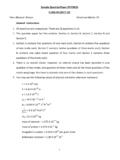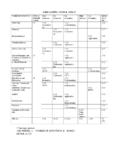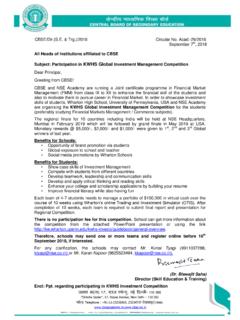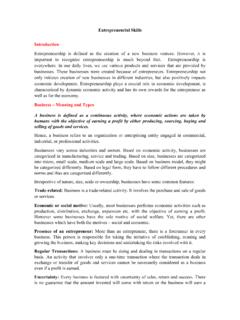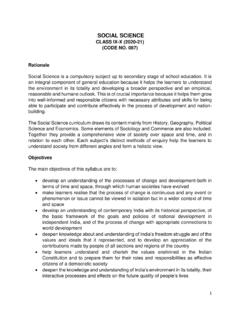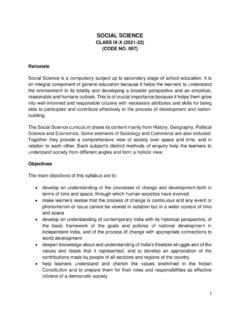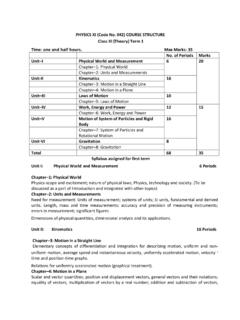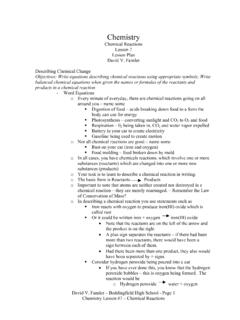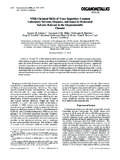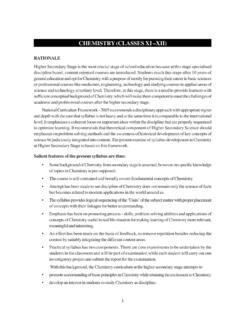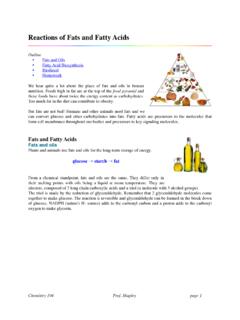Transcription of CHEMISTRY (Code No. 043) 2019-20 - CBSE
1 CHEMISTRY (Code No. 043). 2019-20 . Rationale Higher Secondary is the most crucial stage of school education because at this juncture specialized discipline based, content -oriented courses are introduced. Students reach this stage after 10 years of general education and opt for CHEMISTRY with a purpose of pursuing their career in basic sciences or professional courses like medicine, engineering, technology and other applied areas. Therefore, there is a need to provide learners with sufficient conceptual background of CHEMISTRY , which will make them competent to meet the challenges of academic and professional courses after the senior secondary stage.
2 The new and updated curriculum is based on disciplinary approach with rigour and depth taking care that the syllabus is not heavy and at the same time it is comparable to the international level. The knowledge related to the subject of CHEMISTRY has undergone tremendous changes during the past one decade. Many new areas like synthetic materials, bio -molecules, natural resources, industrial CHEMISTRY are coming in a big way and deserve to be an integral part of CHEMISTRY syllabus at senior secondary stage. At international level, new formulations and nomenclature of elements and compounds, symbols and units of physical quantities floated by scientific bodies like IUPAC and CGPM are of immense importance and need to be incorporated in the updated syllabus.
3 The revised syllabus takes care of all these aspects. Greater emphasis has been laid on use of new nomenclature, symbols and formulations, teaching of fundamental concepts, application of concepts in CHEMISTRY to industry/ technology, logical sequencing of units, removal of obsolete content and repetition, etc. Objectives The curriculum of CHEMISTRY at Senior Secondary Stage aims to: promote understanding of basic facts and concepts in CHEMISTRY while retaining the excitement ofchemistry. make students capable of studying CHEMISTRY in academic and professional courses (such as medicine, engineering, technology) at tertiary level.
4 Expose the students to various emerging new areas of CHEMISTRY and apprise them with their relevance in future studies and their application in various spheres of chemical sciences and technology. equip students to face various challenges related to health, nutrition, environment, population, weather, industries and agriculture. develop problem solving skills in students. expose the students to different processes used in industries and their technological applications. apprise students with interface of CHEMISTRY with other disciplines of science such as physics, biology, geology, engineering etc.
5 Acquaint students with different aspects of CHEMISTRY used in daily life. develop an interest in students to study CHEMISTRY as a discipline. integrate life skills and values in the context of CHEMISTRY . CLASS-XI (THEORY) ( 2019-20 ). COURSE STRUCTURE. Total Periods (Theory 160+ Practical 60). Time: 3 Hours Total Marks70. Unit No. Title No. of Marks Periods Unit I Some Basic Concepts of CHEMISTRY 12 11. Unit II Structure of Atom 14. Unit III Classification of Elements and Periodicity in Properties 08 04. Unit IV chemical Bonding and Molecular Structure 14 21. Unit V States of Matter: Gases and Liquids 12.
6 Unit VI chemical Thermodynamics 16. Unit VII Equilibrium 14. Unit VIII Redox reactions 06 16. Unit IX Hydrogen 08. Unit X s -Block Elements 10. Unit XI p -Block Elements 14. Unit XII Organic CHEMISTRY : Some basic Principles and Techniques 14 18. Unit XIII Hydrocarbons 12. Unit XIV Environmental CHEMISTRY 06. Total 160 70. Unit I: Some Basic Concepts of CHEMISTRY 12 Periods General Introduction: Importance and scope of CHEMISTRY . Nature of matter, laws of chemical combination, Dalton's atomic theory: concept of elements, atoms and molecules. Atomic and molecular masses, mole concept and molar mass, percentage composition, empirical and molecular formula, chemical reactions , stoichiometry and calculations based on stoichiometry.
7 Unit II: Structure of Atom 14 Periods Bohr's model and its limitations, concept of shells and subshells, dual nature of matter and light, de Broglie's relationship, Heisenberg uncertainty principle, concept of orbitals, quantum numbers, shapes of s, p and d orbitals, rules for filling electrons in orbitals - Aufbau principle, Pauli's exclusion principle and Hund's rule, electronic configuration of atoms, stability of half-filled and completely filled orbitals. Unit III: Classification of Elements and Periodicity in Properties 08 Periods Modern periodic law and the present form of periodic table, periodic trends in properties of elements -atomic radii, ionic radii, inert gas radii, Ionization enthalpy, electron gain enthalpy, electronegativity, valency.
8 Nomenclature of elements with atomic number greater than 100. Unit IV: chemical Bonding and Molecular structure 14 Periods Valence electrons, ionic bond, covalent bond, bond parameters, Lewis structure, polar character of covalent bond, covalent character of ionic bond, valence bond theory, resonance, geometry of covalent molecules, VSEPR theory, concept of hybridization, involving s, p and d orbitals and shapes of some simple molecules, molecular orbital theory of homonuclear diatomic molecules(qualitative idea only), hydrogen bond. Unit V: States of Matter: Gases and Liquids. 12 Periods Three states of matter, intermolecular interactions, types of bonding, melting and boiling points, role of gas laws in elucidating the concept of the molecule, Boyle's law, Charles law, Gay Lussac's law, Avogadro's law, ideal behaviour, empirical derivation of gas equation, Avogadro's number, ideal gas equation.
9 Deviation from ideal behaviour, liquefaction of gases, critical temperature, kinetic energy and molecular speeds (elementary idea). Liquid State: vapour pressure, viscosity and surface tension (qualitative idea only, no mathematical derivations). Unit VI: chemical Thermodynamics 16 Periods Concepts of System and types of systems, surroundings, work, heat, energy, extensive and intensive properties, state functions. First law of thermodynamics -internal energy and enthalpy, heat capacity and specific heat, measurement of U and H, Hess's law of constant heat summation, enthalpy of bond dissociation, combustion, formation, atomization, sublimation, phase transition, ionization, solution and dilution.
10 Second law of Thermodynamics (brief introduction).Introduction of entropy as a state function, Gibb's energy change for spontaneous and non- spontaneous processes, criteria for equilibrium. Third law of thermodynamics (brief introduction). Unit VII: Equilibrium 14 Periods Equilibrium in physical and chemical processes, dynamic nature of equilibrium, law of mass action, equilibrium constant, factors affecting equilibrium- Le Chatelier's principle, ionic equilibrium- ionization of acids and bases, strong and weak electrolytes, degree of ionization, ionization of poly basic acids, acid strength, concept of pH, Henderson Equation, hydrolysis of salts (elementary idea), buffer solution, solubility product, common ion effect (with illustrative examples).
